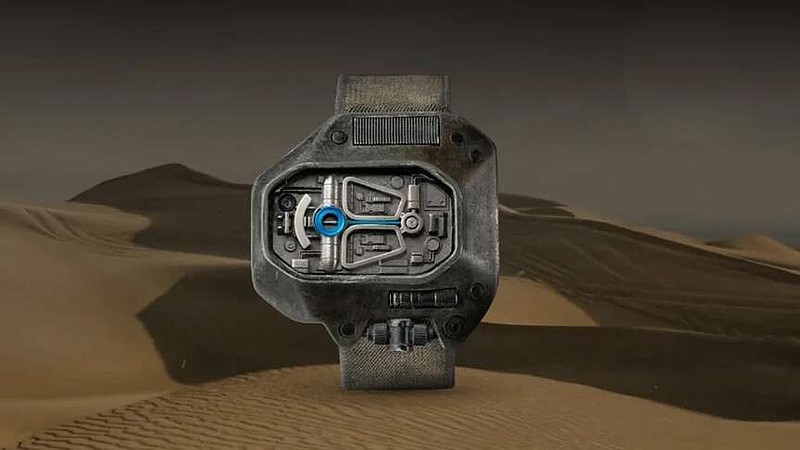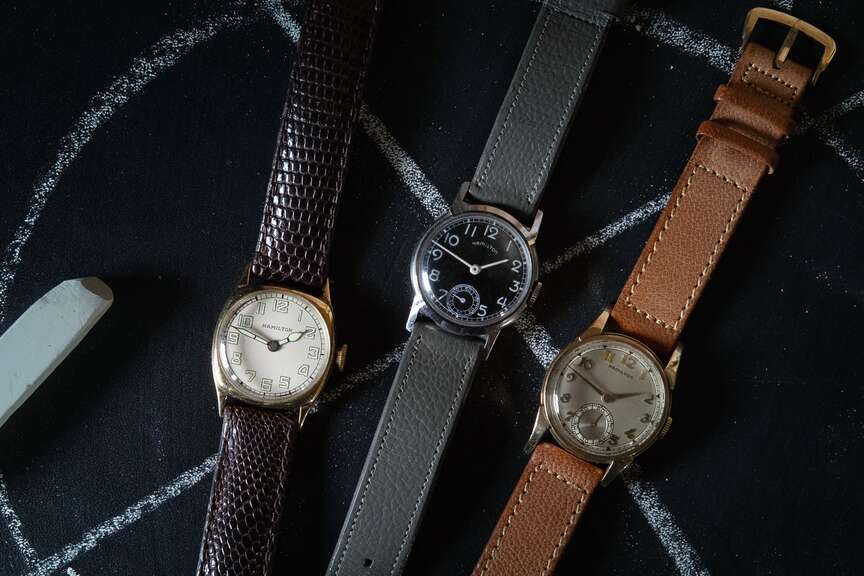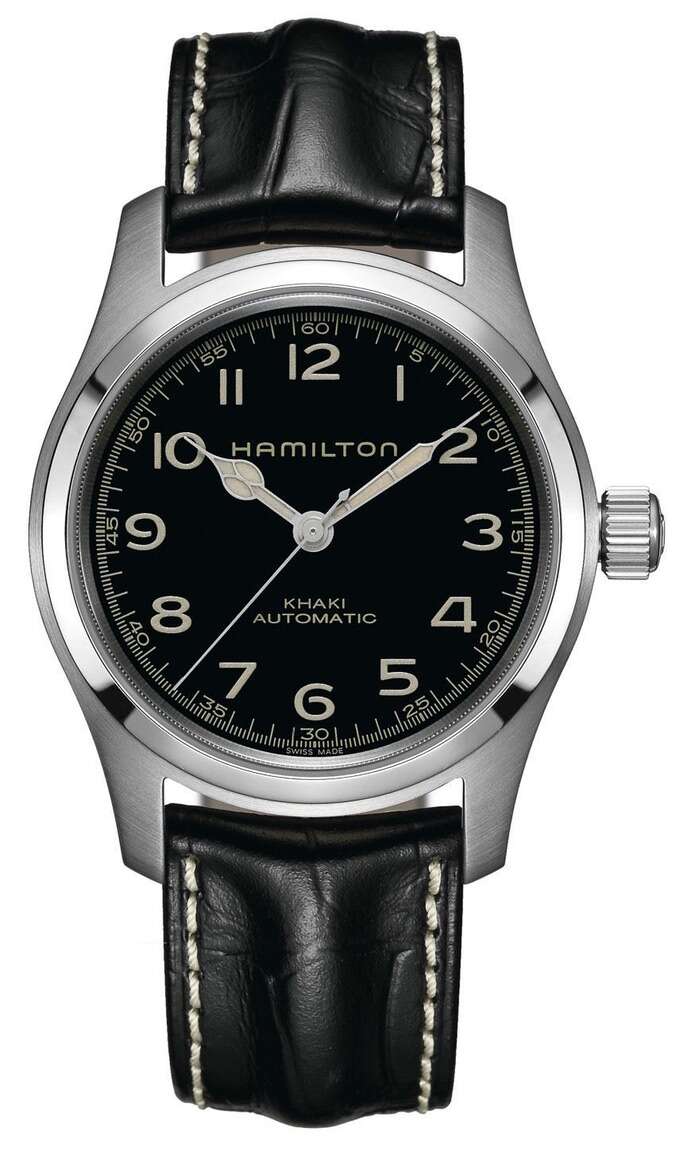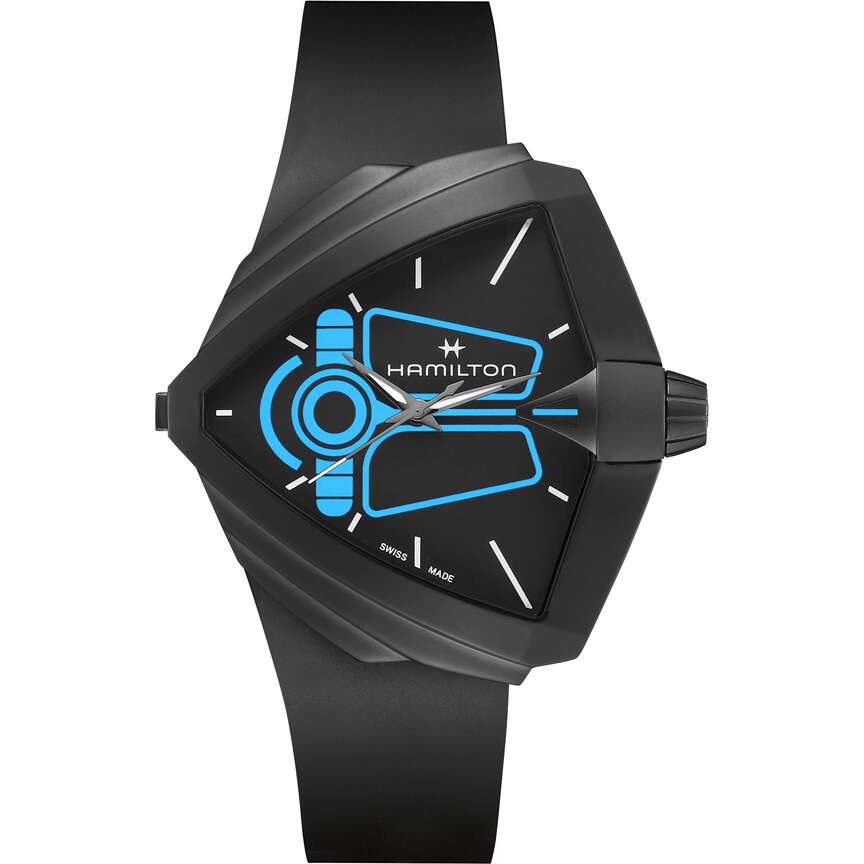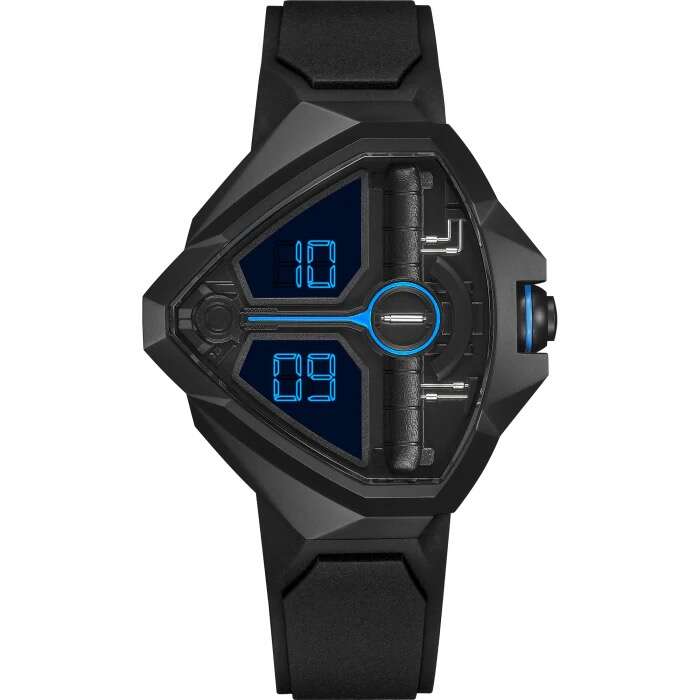Denis Villeneuve's "Dune" movies are set about 18,000 years into the future -- that's what my friend who's really into the Frank Hebert universe tells me. (Though the given year is 10,191, the number has no real correlation to Earth years, since Earth doesn't factor in the novels or movies.)
So it's interesting that the spice-eating Fremen of Arrakis wear wristwatches. Or more precisely, wrist devices. Hamilton Watch Co. -- a Swiss company that was founded as an American firm in 1892 (Hamilton stopped making watches in this country in 1969) and is now part of the Swatch Group, the world's largest watch manufacturing and marketing conglomerate -- collaborated with the filmmakers to produce the prop.
While Hamilton had "no knowledge of the device's function," according to a news release from the company, they submitted to prop master Doug Harlocker a series of sketches for the gimmick based on their Ventura model, which was introduced in 1957 as the company's first "electric" (battery-driven) watch.
The Ventura gained popularity in 1961 when Elvis Presley sported the model in "Blue Hawaii." Rod Serling also wore a Ventura on some episodes of "The Twilight Zone" and, more recently, the Ventura has been featured in all four of the "Men in Black" films, as the official timepiece of MiB agents.
The Fremen prop device, "the Desert Watch," is squatter than the Ventura, with a single blue line (matching the eye color of the Fremen) over a dial consisting of steampunk-esque circuitry, but the Ventura's asymmetrical DNA is evident.
LIMITED EDITIONS
While the prop is just that, Hamilton has released two new limited-edition Ventura: the XXL Bright Dune (suggested retail price $1,750) and the Ventura Edge Dune ($2,500), inspired by the prop. Both of the Dune-inspired models are a little over 50 mm wide, which makes them larger than the standard Ventura (a bit over 32 mm wide and selling for $995), and the $1,695 automatic version released in 2015 to commemorate Presley's 80th birthday.
I haven't seen any of the Hamilton Dune watches in the wild, but the company must have success with this sort of marketing. Hamilton often collaborates with film productions, and its products have been featured in more than 500 films over the years. Cillian Murphy wears three different vintage Hamiltons in his role as Robert Oppenheimer in 2024's Academy Award Winner for Best Picture; Matt Damon wears two as Lt. Gen. Leslie Groves, and Emily Blunt wears a delicate 1947 Lady Hamilton dress watch.
That Hamilton sourced the vintage timepieces from vintage collectors rather than supplying replicas or simply using their modern retro-inspired line of watches might speak to director Christopher Nolan's insistence on period detail and getting things right. Rest assured that while most moviegoers would not be thrown off by anachronistic timepieces on the actors' wrists there does exist a subset of horologically inclined geeks who pay attention to such things.
I am one of those horologically inclined geeks. Whenever a watch features in a scene, I notice -- I know that Don Draper wore a Rolex Explorer in season 4 of "Mad Men" that wouldn't be released until years later and that the gold Citizen 8110A Automatic Bullhead watch that Brad Pitt's character wears in 1969-set "Once Upon a Time ... in Hollywood" wasn't actually available until 1972. (Though I'm willing to cut Quentin Tarantino some slack because his dream worlds never quite align with agreed-upon history.) I remember thinking it was a big deal when James Bond switched from Rolex to Omega (a decision driven by product placement dollars).
ADDS A LAYER
Because people like me exist, a watch is a good way for a director to add a layer to a character, to imply a backstory that extends beyond the time frame of the film. Watches have semiotic value -- a gold Rolex connotes something different from a steel Omega or a plastic Casio. A watch is a choice a character makes, and even casual viewers are likely to infer things from what sort of watch a character wears.
During the first season of HBO's "True Detective," there was chatter about the watch that Matthew McConaughey's Rust Cohle character wore onscreen, a diving watch with a rubber strap, but it didn't get an awful lot of close-up screen time.
Some people speculated that it was a Seiko, but the crown was at three o' clock, which would be unusual. Others thought it might be a Rolex, which might be a stretch for someone of Cohle's economic status (though in some police cultures Rolexes -- or Rolex knockoffs -- are considered de riguer).
Turns out it was a rather obscure model, a Lorus Tidal, that propmaster Lynda Reiss owned. She told the watch website Hoodinkee she "picked that watch because it had a look of something he would have had for quite some time."
'A MILITARY BACKGROUND'
"I think part of the early backstory was that maybe he had a military background," she said, "but also maybe he had done other stuff in his past that we didn't know about. I felt the look of the watch was very simple -- very classic, but very masculine. Even though it's not the most expensive watch in the world, it's also not the cheapest version of that style of watch. I mean, you can get a Timex from the same era that has almost the identical look to it with the bezel and everything else."
Lorus is a Seiko sub-brand -- while the Tidal is no longer being manufactured and as a result of its "True Detective" notoriety is hard to find; a comparable watch like a Seiko 5 or a Citizen Promaster Dive Eco-Drive can be had for a little less than $250. Had Cohle bought his Tidal in the 1980s, he probably would have paid less than $100. So it's appropriate to his character.
Meanwhile, in "Bosch," main character Harry Bosch is a Los Angeles police detective in the first four seasons (who retired to become a private investigator in the most recent two) who sports a stainless-steel Rolex Submariner that would cost between $10,000 and $12,000 today. (There is some debate as to whether the watch is a Submariner or a slightly larger Sea Dweller model; Titus Welliver, who plays Bosch, has confirmed it's a Submariner and it's his personal watch, not a prop, but some watch geeks dissent.)
PAID HANDSOMELY
In Bosch's case, it makes sense that he might own an expensive watch -- part of his backstory is that he worked as a technical adviser on a miniseries made from one of his cases and was paid handsomely for the job. That's how he can afford his Hollywood Hills house with the spectacular view -- a property that Zillow estimates would sell for $2,276,400.
Bosch's watch intimates something of his history. In 1995 Val Kilmer wore a Jaeger-LeCoultre Reverso on his wrist as Bruce Wayne; the Reverso is a watch that hides its face, flipping over so its case back is visible and its dial protected. When Nolan took over the franchise, Christian Bale's Bruce Wayne continued to wear the symbol.
Other times, watch choice has more to do with the actor than the character.
Robert Redford wore a Rolex Submariner reference 1680, with the Submariner script on the dial of the watch in red rather than the usual white, in 1972's "The Candidate," 1975's "Three Days of the Condor," 1976's "All the President's Men" and 1979's "The Electric Horseman."
HIS PERSONAL WATCH
He was also photographed wearing the same model off-screen at the 1972 Cannes Film Festival and the Directors Guild Awards in 1981. (In "Three Days of the Condor," Redford also wore a Doxa Shark Hunter in some scenes.)
Some people have characterized Redford's Rolex in "All the President's Men" as a mistake on the grounds that the Bob Woodward he played was a struggling young reporter. But while a Rolex Submariner would have been considered an expensive watch in the '70s -- in 1975 you could have bought one similar to Redford's for around $250 (about $1,500 today) -- they were not the luxury items they're considered today. They wouldn't be out of reach of the characters he played.
The real Woodward wore a Heuer (now TAG Heuer) chronograph in the mid-'70s; a watch that, while not as costly as a Submariner, would have run him about $200. These days, Woodward often wears a Rolex Datejust.
On the other hand, to play Carl Bernstein, Dustin Hoffman, a more method-y actor than Redford, persuaded the real Bernstein to loan him his watch and wallet for the film.
■ ■ ■
The Dune collaboration wasn't the first time Hamilton produced a watch "inspired" by one of Nolan's movies.
For 2014's "Interstellar," Nolan tasked the brand to mock a watch that didn't exist in their collection -- a simple field watch without a date complication for Cooper (Matthew McConaughey) to give to his daughter Murph (Mackenzie Foy) before leaving Earth on a mission to find a new habitable planet. The watch is the means by which he will communicate from space with the adult Murph (played by Jessica Chastain) decades later.
While that watch was never meant to go into actual production, Hamilton released a special edition of "the Murph" in 2019; it's now a regular part of its catalog. (It sells for $995, with a smaller 38 mm version selling for $895.) Nolan reportedly wears a Murph regularly.
Hamilton also conceived two digital watches for his 2020 film "Tenet," one with a red LED display and the other with blue. Like the "Dune" Desert Watch, these prop watches were never produced as actual watches -- to work they required big off-screen battery packs and wires -- but they did inspire Hamilton's special edition Khaki Navy BeLOWZERO automatic watch, which sold for $2,095. On the Hamilton website there's a disclaimer that points out the watch "does not feature the digital screen that appears on the custom-made prop watch."
A LIMITED RUN
(The watch run, limited to 888 pieces, has sold out, but the very similar Khaki Navy BeLOWZERO automatic titanium watch, featured in both "Tenet" and 2016's "The Martian," is still available, at suggested retail $1,945.)
Hamilton also sells a version of the watch Harrison Ford wore in last year's "Indiana Jones and the Dial of Destiny," a quartz-powered modern take on the classic rectangular-cased Boulton design introduced in 1941. Their website offers a "movie collection," in which various watch models that have appeared on screen can be easily found.
You can order the Khaki Field Mechanical (wind-up) Bronze watch ($895) Michael Douglas wore in 2023's "Ant-Man and the Wasp: Quantumania") or the Khaki Field Automatic Chris Evans' Steve Rogers wore in 2012's "The Avengers."
■ ■ ■
Part of the reason wristwatches -- which, thanks to the ubiquity of smartphones have been rendered superfluous as a needed tool -- seem to have a long tail is because their status as signifiers of social class and taste is reinforced by their appearance on the wrists of stars and cultural influencers.
A lot of us get into watches for the same reason some people start to smoke: the coolness factor. Those of us who wear wristwatches wear them for the same reasons that filmmakers put them in their movies, because they suggest a backstory that needn't be explicitly told.
And because the movies teach us style.
As unnecessary as they are, they persist. Not everyone wears them. And while it is notoriously difficult to get anything close to an accurate estimate on how many watches are sold each year -- many of the leading Swiss manufacturers such as Rolex do not release sales figures -- some experts estimate the Swiss watch industry alone produces and sells about 20 million watches per year.
20 MILLION A YEAR
That 20 million is said to represent only about 2% of of global production, which would mean about a billion watches are produced and sold each year. (Some sources guess the figure may be closer to 1.2 billion watches manufactured and sold each year.)
Wristwatches are like cars and firearms, and other pieces of gear; it's not so much their function we care about but what they advertise about their owners. An expensive watch is gauche, a conspicuous display of one's wherewithal.
As Paul Fussell wrote in his indispensable 1983 book "Class: A Guide Through the American Status System": "The general class rule about wristwatches is the more scientific, technological, and space-age, the lower. Likewise with the more information the watch is supposed to convey, like the time of day in Kuala Lumpur, the number of days elapsed in the year so far, or the current sign of the zodiac.
"Some upper-class devotees of the Cartier tank watch with the black lizard strap will argue that even a second hand compromises a watch's class, implying as it may the wearer's need for great accuracy, as if he were something like a professional timer of bus arrivals and departures. The other upper-class watch is the cheapest and simplest Timex, worn with a grosgrain ribbon strap, changed often: black ones for formal wear are amusing."
Fussell was correct; there is a certain out-of-sight old-money sort who drives a beat-up Dodge and quietly conspires to fix the world, who has no need of diverting complications. But most of us can learn to love machines that marry art and technology and the things we wear.
Email: pmartin@adgnewsroom.com
